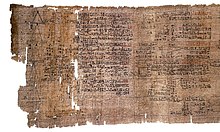History of combinatorics
Its study in Europe dates to the work of Leonardo Fibonacci in the 13th century AD, which introduced Arabian and Indian ideas to the continent.
[1] In Greece, Plutarch wrote that Xenocrates of Chalcedon (396–314 BC) discovered the number of different syllables possible in the Greek language.
[5][6] There is also evidence that in the Ostomachion, Archimedes (3rd century BC) considered the configurations of a tiling puzzle,[7] while some combinatorial interests may have been present in lost works of Apollonius.
[10] In the second century BC, Pingala included an enumeration problem in the Chanda Sutra (also Chandahsutra) which asked how many ways a six-syllable meter could be made from short and long notes.
[1] The Middle East also learned about binomial coefficients from Indian work and found the connection to polynomial expansion.
In a passage from the work of Arab mathematician Umar al-Khayyami that dates to around 1100, it is corroborated that the Hindus had knowledge of binomial coefficients, but also that their methods reached the middle east.
In a now lost work known only from subsequent quotation by al-Samaw'al, Al-Karaji introduced the idea of argument by mathematical induction.
The philosopher and astronomer Rabbi Abraham ibn Ezra (c. 1140) counted the permutations with repetitions in vocalization of Divine Name.
[16] He also established the symmetry of binomial coefficients, while a closed formula was obtained later by the talmudist and mathematician Levi ben Gerson (better known as Gersonides), in 1321.
[17] The arithmetical triangle—a graphical diagram showing relationships among the binomial coefficients— was presented by mathematicians in treatises dating as far back as the 10th century, and would eventually become known as Pascal's triangle.
Later, in Medieval England, campanology provided examples of what is now known as Hamiltonian cycles in certain Cayley graphs on permutations.
[23][24] De Moivre also managed to approximate the binomial coefficients and factorial, and found a closed form for the Fibonacci numbers by inventing generating functions.
Problems Euler worked on include the Knights tour, Graeco-Latin square, Eulerian numbers, and others.
[27] In the 19th century, the subject of partially ordered sets and lattice theory originated in the work of Dedekind, Peirce, and Schröder.

